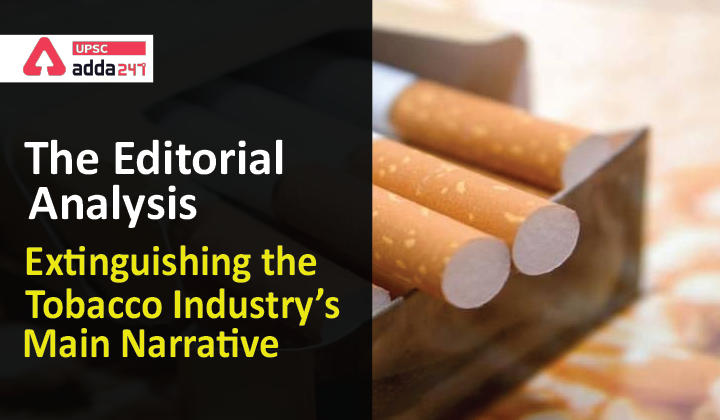Table of Contents
Extinguishing the Tobacco Industry’s Main Narrative- Relevance for UPSC
- GS Paper 2: Governance, Administration and Challenges- Government policies and interventions for development in various sectors and issues arising out of their design and implementation.
Extinguishing the Tobacco Industry’s Main Narrative- Context
- There is no doubt that tobacco use is highly detrimental to public health. We have to find the ways and the means to reduce the demand for tobacco among existing as well as aspiring users.
The Editorial Analysis: The Chinese challenge uncovers India’s fragilities
Extinguishing the Tobacco Industry’s Main Narrative- Associated Data
- Loss of Human Lives: Tobacco is a product that kills more than 13 lakh Indians every year.
- Economic Cost: The annual economic burden from tobacco use is estimated to be ₹177,340 crore which is more than 1% of India’s GDP.
- The economic burden from tobacco use in India has increased by 22% in real terms over the period 2011 to 2017.
- There has been a 3% real decline in Goods and Services Tax (GST) revenues from tobacco products in the past two financial years.
- Burden on Human Capital of India: About 27 crore people above the age of 15 years and 8.5% of school-going children in the age group 13-15 years use tobacco in some form in India.
The Editorial Analysis- The Crypto Assets Conundrum
Extinguishing the Tobacco Industry’s Main Narrative- Associated Issues
- Issue of increasing illicit trade of Tobacco products: The tobacco industry has maintained that the illegal cigarette trade accounts for as much as 25% of the cigarette market in India.
- It was said that the illicit cigarette volume in India has grown by 44% from 2011 to 2019.
- Large Tobacco Industry Opposing Tax Raise: by saying that high and increasing tax rates provide a profitable opportunity for tax evasion and encourage growth in illegal trade.
- The tobacco industry, globally, is always devising tactics and narratives that will pre-empt any kind of tax increases on tobacco products.
- Lack of Credibility of Data: Closure observation of the Tobacco industry’s data shows neither the estimates nor the methods used to derive them are backed by any transparent studies.
- Governance Issues: Several factors play a larger role in determining the scale and the extent of an illicit market such as-
- Quality of tax administration,
- Strength of the regulatory framework,
- Government commitment to control illicit trade,
- Strength of governance, social acceptance, and
- Presence of informal distribution networks.
Extinguishing the Tobacco Industry’s Main Narrative- Debunking Tobacco Industry’s Claims
- Low Illicit cigarette trade:
- A 2018 survey of empty cigarette packs collected from retail outlets across different cities in India estimated that illicit cigarettes constitute 2.7% of the market.
- A 2020 survey that used tax-gap analysis to estimate that the percentage of illicit cigarettes was 5.1% in 2009-10 and 6.6% in 2016-17.
- Both these studies used transparent and replicable methods and their estimates of the illicit market were nowhere near the 25% figure that the tobacco industry in India has been using to influence the public discourse on tobacco taxation.
- Growth in Illicit Trade is Unrelated to tax increases: There is sufficient evidence that shows tax increases only have a minimal impact, if at all, on illicit trade.
- There are several countries where tobacco taxes are quite high and yet have low levels of illicit trade.
- There are also countries with high levels of illicit trade despite having relatively low tax rates.
Extinguishing the Tobacco Industry’s Main Narrative- Way Forward
- Cost and Economic Measure: A large body of literature shows price and tax measures to be one of the most cost-effective measures to reduce demand for tobacco products.
- When tobacco products become more expensive, people either quit using them or use them less, and it incentivizes many to not initiate the habit.
- Implementing WHO’s Framework Convention on Tobacco Control: India has already ratified the WHO’s Protocol to Eliminate Illicit Trade in Tobacco Products.
- WHO’s Protocol to Eliminate Illicit Trade in Tobacco Products aims at eliminating all forms of illicit trade in tobacco products through a package of measures.
- The Protocol provides the tools and the measures to eliminate or minimize illicit trade which includes-
- Strong governance,
- Establishing an international track and trace system, and
- Securing supply chains.
- India should now show leadership in implementing these measures to effectively address even the relatively lower levels of illicit trade.
- Increasing tax on Tobacco Products: India had no significant tax increases on any of the tobacco products for the past four years since the introduction of GST in 2017.
- Due to the above, tobacco products have become more affordable as shown in recent studies.
- The present situation demands raising tax on tobacco products by the government. This could reduce tobacco use among the Indian youth.




 TSPSC Group 1 Question Paper 2024, Downl...
TSPSC Group 1 Question Paper 2024, Downl...
 TSPSC Group 1 Answer key 2024 Out, Downl...
TSPSC Group 1 Answer key 2024 Out, Downl...
 UPSC Prelims 2024 Question Paper, Downlo...
UPSC Prelims 2024 Question Paper, Downlo...
